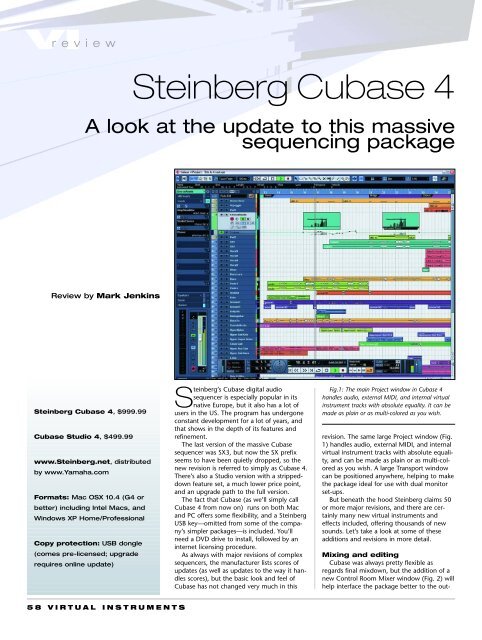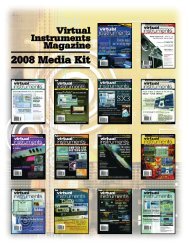Akai EWI 4000m Electric Wind Instrument Akai EWI 4000m Electric ...
Akai EWI 4000m Electric Wind Instrument Akai EWI 4000m Electric ...
Akai EWI 4000m Electric Wind Instrument Akai EWI 4000m Electric ...
Create successful ePaper yourself
Turn your PDF publications into a flip-book with our unique Google optimized e-Paper software.
VI review<br />
Steinberg Cubase 4, $999.99<br />
Cubase Studio 4, $499.99<br />
www.Steinberg.net, distributed<br />
by www.Yamaha.com<br />
Formats: Mac OSX 10.4 (G4 or<br />
better) including Intel Macs, and<br />
<strong>Wind</strong>ows XP Home/Professional<br />
Copy protection: USB dongle<br />
(comes pre-licensed; upgrade<br />
requires online update)<br />
Steinberg Cubase 4<br />
A look at the update to this massive<br />
sequencing package<br />
Review by Mark Jenkins<br />
58 VIRTUAL INSTRUMENTS<br />
Steinberg’s Cubase digital audio<br />
sequencer is especially popular in its<br />
native Europe, but it also has a lot of<br />
users in the US. The program has undergone<br />
constant development for a lot of years, and<br />
that shows in the depth of its features and<br />
refinement.<br />
The last version of the massive Cubase<br />
sequencer was SX3, but now the SX prefix<br />
seems to have been quietly dropped, so the<br />
new revision is referred to simply as Cubase 4.<br />
There’s also a Studio version with a strippeddown<br />
feature set, a much lower price point,<br />
and an upgrade path to the full version.<br />
The fact that Cubase (as we’ll simply call<br />
Cubase 4 from now on) runs on both Mac<br />
and PC offers some flexibility, and a Steinberg<br />
USB key—omitted from some of the company’s<br />
simpler packages—is included. You’ll<br />
need a DVD drive to install, followed by an<br />
internet licensing procedure.<br />
As always with major revisions of complex<br />
sequencers, the manufacturer lists scores of<br />
updates (as well as updates to the way it handles<br />
scores), but the basic look and feel of<br />
Cubase has not changed very much in this<br />
Fig.1: The main Project window in Cubase 4<br />
handles audio, external MIDI, and internal virtual<br />
instrument tracks with absolute equality. It can be<br />
made as plain or as multi-colored as you wish.<br />
revision. The same large Project window (Fig.<br />
1) handles audio, external MIDI, and internal<br />
virtual instrument tracks with absolute equality,<br />
and can be made as plain or as multi-colored<br />
as you wish. A large Transport window<br />
can be positioned anywhere, helping to make<br />
the package ideal for use with dual monitor<br />
set-ups.<br />
But beneath the hood Steinberg claims 50<br />
or more major revisions, and there are certainly<br />
many new virtual instruments and<br />
effects included, offering thousands of new<br />
sounds. Let’s take a look at some of these<br />
additions and revisions in more detail.<br />
Mixing and editing<br />
Cubase was always pretty flexible as<br />
regards final mixdown, but the addition of a<br />
new Control Room Mixer window (Fig. 2) will<br />
help interface the package better to the out-



